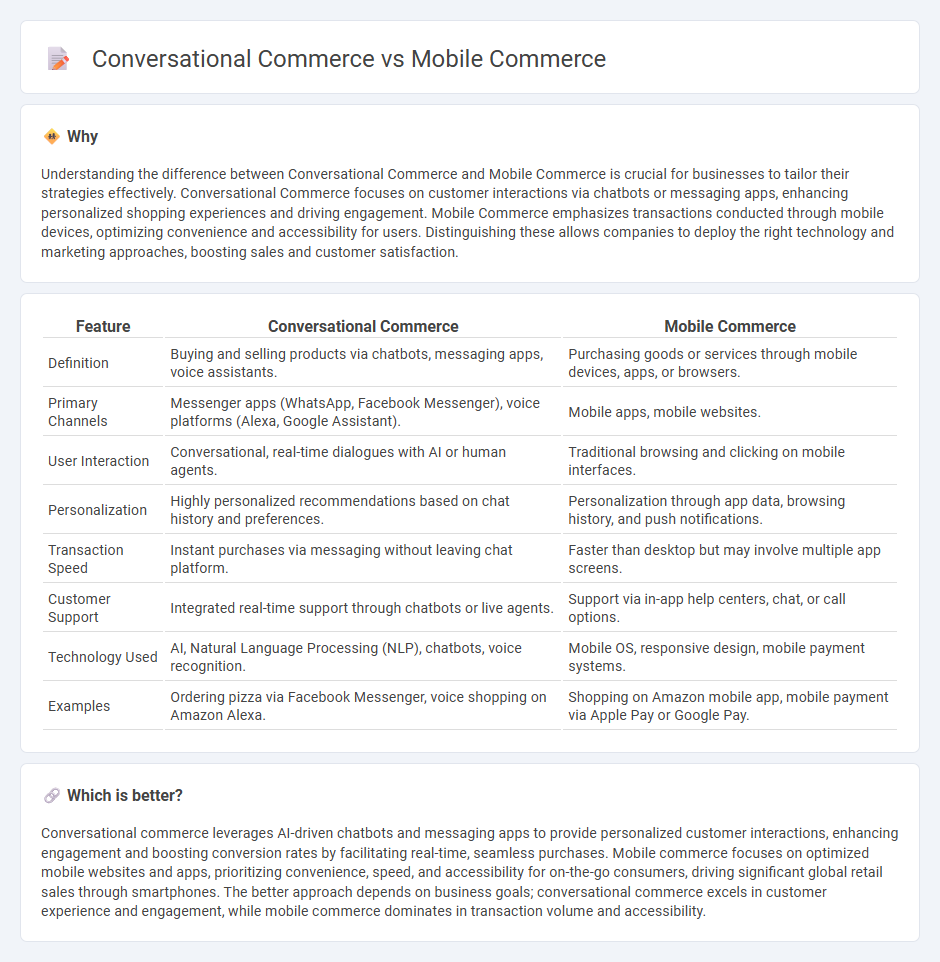
Conversational commerce leverages chatbots and voice assistants to facilitate direct, personalized shopping experiences through messaging platforms, enhancing customer interaction and convenience. Mobile commerce focuses on buying and selling goods via smartphones and tablets, optimizing websites and apps for seamless transactions on the go. Discover how these two trends reshape the future of digital retail and customer engagement.
Why it is important
Understanding the difference between Conversational Commerce and Mobile Commerce is crucial for businesses to tailor their strategies effectively. Conversational Commerce focuses on customer interactions via chatbots or messaging apps, enhancing personalized shopping experiences and driving engagement. Mobile Commerce emphasizes transactions conducted through mobile devices, optimizing convenience and accessibility for users. Distinguishing these allows companies to deploy the right technology and marketing approaches, boosting sales and customer satisfaction.
Comparison Table
| Feature | Conversational Commerce | Mobile Commerce |
|---|---|---|
| Definition | Buying and selling products via chatbots, messaging apps, voice assistants. | Purchasing goods or services through mobile devices, apps, or browsers. |
| Primary Channels | Messenger apps (WhatsApp, Facebook Messenger), voice platforms (Alexa, Google Assistant). | Mobile apps, mobile websites. |
| User Interaction | Conversational, real-time dialogues with AI or human agents. | Traditional browsing and clicking on mobile interfaces. |
| Personalization | Highly personalized recommendations based on chat history and preferences. | Personalization through app data, browsing history, and push notifications. |
| Transaction Speed | Instant purchases via messaging without leaving chat platform. | Faster than desktop but may involve multiple app screens. |
| Customer Support | Integrated real-time support through chatbots or live agents. | Support via in-app help centers, chat, or call options. |
| Technology Used | AI, Natural Language Processing (NLP), chatbots, voice recognition. | Mobile OS, responsive design, mobile payment systems. |
| Examples | Ordering pizza via Facebook Messenger, voice shopping on Amazon Alexa. | Shopping on Amazon mobile app, mobile payment via Apple Pay or Google Pay. |
Which is better?
Conversational commerce leverages AI-driven chatbots and messaging apps to provide personalized customer interactions, enhancing engagement and boosting conversion rates by facilitating real-time, seamless purchases. Mobile commerce focuses on optimized mobile websites and apps, prioritizing convenience, speed, and accessibility for on-the-go consumers, driving significant global retail sales through smartphones. The better approach depends on business goals; conversational commerce excels in customer experience and engagement, while mobile commerce dominates in transaction volume and accessibility.
Connection
Conversational commerce leverages chatbots and messaging apps to facilitate seamless shopping experiences directly within conversations, enhancing user engagement on mobile devices. Mobile commerce provides the essential platform for conversational commerce by enabling real-time transactions and personalized interactions through smartphones and tablets. Together, they drive increased online sales by combining intuitive communication with the convenience of mobile accessibility.
Key Terms
Mobile Apps
Mobile commerce leverages mobile apps to facilitate seamless shopping experiences through features like in-app payments, personalized product recommendations, and location-based offers. Conversational commerce integrates chatbots and voice assistants within mobile apps to provide real-time customer support, product suggestions, and streamlined transactions. Explore how combining mobile and conversational commerce strategies can boost user engagement and drive sales growth.
Chatbots
Mobile commerce leverages smartphones for seamless shopping experiences through apps and mobile-optimized websites, streamlining transactions with features like mobile wallets and push notifications. Conversational commerce centers around chatbots and messaging platforms to facilitate personalized customer interactions, instant support, and product recommendations directly within chat interfaces. Explore how integrating advanced chatbot technologies transforms customer engagement and drives sales in the evolving digital marketplace.
In-app Messaging
Mobile commerce leverages in-app messaging to streamline product discovery, facilitate secure payments, and enhance user engagement within mobile applications. Conversational commerce uses AI-driven chatbots and live agent messaging to provide personalized shopping assistance, resolve customer queries, and drive sales directly through interactive conversations. Explore how integrating in-app messaging transforms both mobile and conversational commerce for superior customer experiences.
Source and External Links
What Is Mobile Commerce (and Why It's a Strategy You ... - Mobile commerce, or mCommerce, is any monetary transaction conducted through a mobile device, offering faster purchases, better customer experience, direct connection to customers via push notifications, and personalized content that benefits businesses by enhancing scalability and customer relations.
The Rise of M-Commerce: Why Mobile is the Future of Online ... - M-commerce involves buying and selling goods via mobile devices and is rapidly growing, with mobile devices accounting for 60% of online browsing in late 2023 and mobile wallets enabling nearly half of ecommerce transactions worldwide, highlighting the critical need for businesses to adopt mobile-first strategies.
What is Mobile Commerce? - Mobile commerce refers to shopping, banking, or payment transactions conducted online through smartphones or tablets, driven by increasing consumer attachment to mobile devices and enhanced by mobile-friendly websites, dedicated apps, and social media platforms enabling seamless mobile shopping experiences.
 dowidth.com
dowidth.com